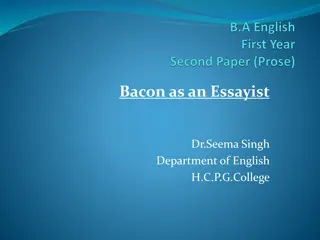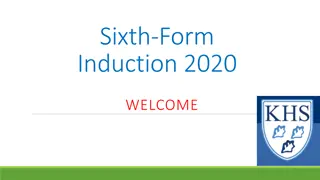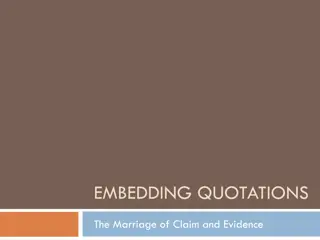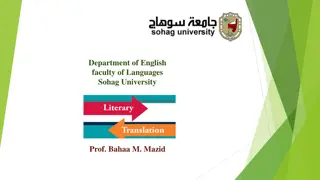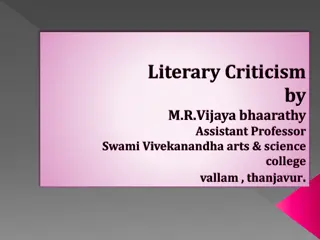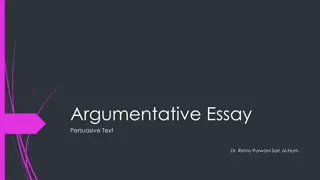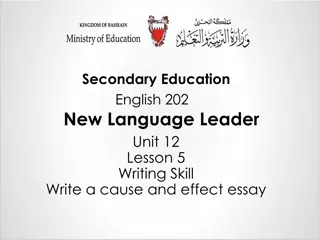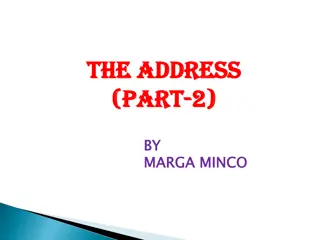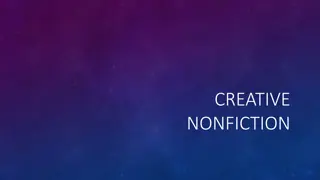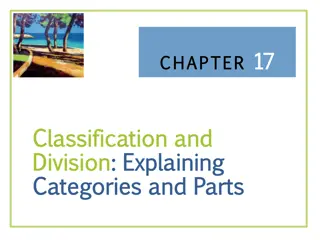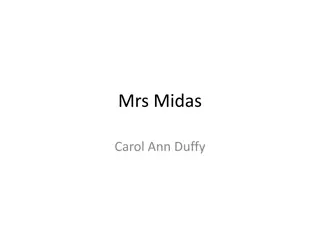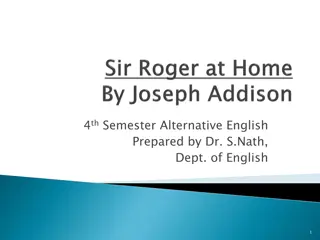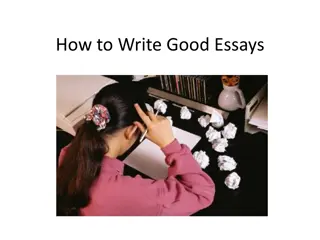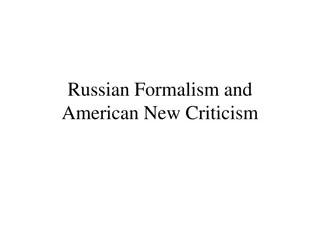Mrs. Cavolt's Guide to Literary Analysis Essays
Delve into the art of crafting a literary analysis essay guided by Mrs. Cavolt. Understand the nuances of thesis statements, topic sentences, and evidence while learning to discuss literature with a specific focus. Follow the set-up for a well-structured essay and avoid common pitfalls such as using personal pronouns. Enhance your analysis skills by exploring morally ambiguous qualities in literary works and forming compelling arguments through your thesis statements.
Download Presentation

Please find below an Image/Link to download the presentation.
The content on the website is provided AS IS for your information and personal use only. It may not be sold, licensed, or shared on other websites without obtaining consent from the author.If you encounter any issues during the download, it is possible that the publisher has removed the file from their server.
You are allowed to download the files provided on this website for personal or commercial use, subject to the condition that they are used lawfully. All files are the property of their respective owners.
The content on the website is provided AS IS for your information and personal use only. It may not be sold, licensed, or shared on other websites without obtaining consent from the author.
E N D
Presentation Transcript
Literary Analysis 1 Thesis Statements 2 Topic Sentences 3 Evidence 4
The goal of a Literary Analysis Essay is to discuss your interpretation of a piece of literature using a specific literary focus (like motifs, themes, humor, characterization, or, in our case, moral ambiguity )
Never use I, you, we, our (even though this is your interpretation, you may not provide opinions) Always talk about literature in present tense Do not retell the story in your essay (this is not a book report)
Paper set-up Intro with thesis 1stBody Paragraph- Elaborates on one morally ambiguous quality 2ndBody Paragraph- Elaborates on another morally ambiguous quality 3rdBody Paragraph- Elaborates on yet another morally ambiguous quality Conclusion All of your Paragraphs must directly connect to your thesis!!!
What is a literary analysis essay? What does it do? What tense does your essay need to be in? What are some words you may not use in your essay (unless in your quotes)? How is this literary analysis essay set up?
Thesis statements make an argumentthat you work to prove throughout your essay. It is NOT your TITLE (although your TITLE should certainly relate to your THESIS) It is NOT a statement of fact or opinion (i.e., Frankenstein is a novel with morally ambiguous characters in it. )
Thesis Throughout Frankenstein, [insert character] is shown to exhibit both good and evil qualities. Mary Shelley s portrayal of [insert character] as a morally ambiguous character uncovers the significance to the meaning of the work as a whole. Example: Throughout Frankenstein,the monster is shown to exhibit both good and evil qualities. Mary Shelley s portrayal of the monster as a morally ambiguous character uncovers the significance to the meaning of the work as a whole. I am arguing that the monster is a morally ambiguous character and that Shelley s portrayal of the monster in this way is significant to the novel.
What are thesis statements supposed to do/not do in a literary analysis essay?
Topic sentences must directly connect to your thesis statement and work as the reasons that prove your thesis. What that means is that you must use the same wording in each of your topic sentences as you use in your thesis.
Thesis: Throughout Frankenstein, the monster is shown to exhibit both good and evil qualities. Mary Shelley s portrayal of the monster as a morally ambiguous character uncovers the significance to the meaning of the work as a whole. Topic Sentences: BP #1-The monster is morally ambiguous because he commits violent, evil murders throughout the novel, yet only murders because of the knowledge he has gained through watching society s behaviors. BP #2-The monster is also neither good nor evil because he has a good heart and only wishes to be accepted by society, yet he realizes that he will never be accepted and yearns for revenge. BP#3-Furthermore, the monster is morally ambiguous to the reader because he ends up inadvertently killing Victor by taking him on a hunt for him, yet does this simply because he is lonely.
Notice, your topic sentence must show one reason why the character is morally ambiguous. Therefore, you have to show one trait (good or evil) and another that opposes that trait. This is what makes the character morally ambiguous! What are some morally ambiguous traits you can think of? He steals food, yet he only does this because he is hungry. She likes to gossip, yet she only does this because she is insecure about her self. Can you think of any others? Pair share.
Notice, your topic sentence must show onereason why the character is morally ambiguous. Therefore, you have to show one trait (goodor evil) and another that opposes that trait. This is what makes the character morally ambiguous! BP #1-The monster is morally ambiguous because he commits violent, evil murders throughout the novel, yet only murders because of the knowledge he has gained through watching society s behaviors. BP #2-The monster is also neither good nor evil because he has a good heart and only wishes to be accepted by society, yet he realizes that he will never be accepted and yearns for revenge. BP#3- Furthermore, the monster is morally ambiguous to the reader because he ends up inadvertently killing Victorby taking him on a hunt for him, yet does this simply because he is lonely.
Come up with one topic sentence for your essay. Raise your hand when you are done so I can come over and check it.
Evidence must directly support your topic sentence and thesis statement (after choosing it, check if it proves your thesis and topic sentence) prove your argument be a quote taken directly from the novel (for each paragraph!!!)
T.S. #2-The monster is also neither good nor evil because he has a good heart and only wishes to be accepted by society, yet he realizes that he will never be accepted and yearns for revenge. Evidence: I had saved a human being from destruction, and as a recompense I now writhed under the miserable pain of the wound which shattered the flesh and bone[ ] I vowed eternal hatred and vengeance to all mankind (Shelley 143). Does this evidence support my topic sentence, thesis, and prove my argument?
Always set your evidence up by providing context for your quote. Answer the who, what, where, when, and how After the monster suffered yet another violent encounter from society, he stumbles on a human drowning and after saving her he is shot by another human. He clearly understands that although [He] had saved a human being from destruction, and as a recompense [he] now writhed under the miserable pain of the wound which shattered the flesh and bone [ ] [he] vowed eternal hatred and vengeance to all mankind (Shelley 143).
If you have a longer quote and you do not need to include everything OR you are taking a section of a quote OR you need to insert a word, use brackets and ellipses. I had saved a human being from destruction, and as a recompense I now writhed under the miserable pain of the wound which shattered the flesh and bone[ ] I vowed eternal hatred and vengeance to all mankind (Shelley 143). [ ] writhed under the miserable pain of the wound which shattered flesh and bone (Shelley 143). I now writhed under the miserable pain [from the gunshot] which shattered flesh and bone (Shelley 143).
What is evidence? What does the evidence do? What are the three ways to use brackets?
Literary Analysis 1 Thesis Statements 2 Topic Sentences 3 Evidence 4 Parenthetical Citations 5 Analysis 6 Effective Intros and Conclusions 7
Why use parenthetical citations? Parenthetical citations tell the reader exactly where you found your evidence so the reader could technically find your quote if he/she wishes to do more research or confirm where you found your info. It is absolutely necessary that you follow the correct format (it is part of the MLA guidelines)
Format for novels only: Quote (Author s Last Name page number). no punctuation here! Quotation marks follow the quote. period goes after the citation no punctuation inside the parenthesis Quote (Shelley 36).
When you set a quote into the middle of a sentence, you always cite at the end of the sentence not the end of the quote. Example: Victor exclaimed, Beautiful- Great God when he first looked upon the monster he had created(Shelley 58).
Add parenthetical citations to each of your quotes in your outline.
Cannot be a summary of the novel or a recap of your evidence. The goal of analysis is to prove your thesis and topic sentences and show the significance of your evidence. You need to dig-deeper to reveal something new to your audience. THIS IS THE MOST IMPORTANT ASPECT OF YOUR ESSAY- IT SHOULD BE AT LEAST 3-5 SENTECNES AND IT MUST BE WELL THOUGHT OUT!!!!!
To discuss for this essay: Explain how this [evidence] is an example of moral ambiguity (what makes this character neither good nor evil?) Explain why this [evidence] is significant to the novel (why is it important that Shelley made this character morally ambiguous?). Make sure this directly connects to your evidence, topic sentence and thesis.
You want to use/mention as many literary devices as possible to help with your interpretation: Romantic/Gothic characteristics Character types Foil And/or allusions Think of ways you can incorporate these into your essay.
The monster is also neither good nor evil because he has a good heart and only wishes to be accepted by society, yet he realizes that he will never be accepted and yearns for revenge. After the monster suffered yet another violent encounter from society, he stumbles on a human drowning and after saving her he is shot by another human. He clearly understands that although [He] had saved a human being from destruction, [...] as a recompense [he] now writhed under the miserable pain of the wound which shattered the flesh and bone [ ] [he] vowed eternal hatred and vengeance to all mankind (Shelley 143). The monster is a dynamic being with a good heart, yet over and over again he is hurt and this time he vows revenge. It is clear that the monster resorts to take out his violent revenge on society only after he has determined once and for all that he will never fit in with other humans because of his hideous appearance. The monster s moral ambiguity is significant to the novel because the readers sympathize with the monster even after he commits violent murders because the readers know he tried everything in his power to interact kindly with them. Even though he is a monster, Shelley forces the readers to see his good heart in hopes that they will be left to decide who the real monster is in the end.



